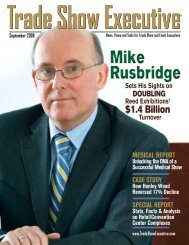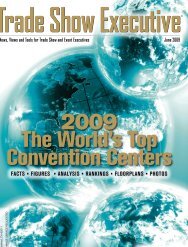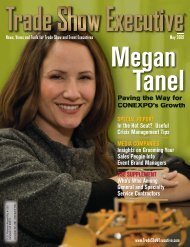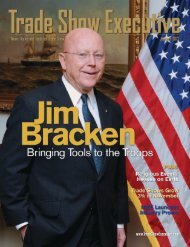TIM LESMEISTER - Trade Show Executive
TIM LESMEISTER - Trade Show Executive
TIM LESMEISTER - Trade Show Executive
You also want an ePaper? Increase the reach of your titles
YUMPU automatically turns print PDFs into web optimized ePapers that Google loves.
Sponsored by<br />
PrivilegedAccess.tv<br />
year for three years if the borrower stays<br />
current.<br />
Another aspect of the plan helps<br />
borrowers who can’t refinance to a lower<br />
rate because the value of their home has<br />
slipped below the mortgage they owe.<br />
These slightly “underwater” borrowers<br />
must have a loan held by Fannie Mae or<br />
Freddie Mac and don’t owe more than<br />
105% of their home’s current value. The<br />
plan also calls for the U.S. Treasury to<br />
strengthen Fannie Mae and Freddie Mac<br />
by injecting another $100 billion into<br />
each mortgage company. This program,<br />
named the Homeowner Affordability<br />
and Stability Plan, starts March 4 and is<br />
estimated to help nine million people.<br />
However, there have been some<br />
criticisms of the plan, Chow pointed<br />
out. The more prices fall, the fewer<br />
homeowners will qualify for the plan<br />
since it is restricted to the 105% value<br />
limit. According to Moody’s Economy.<br />
com, almost 14 million homeowners<br />
are already underwater, meaning they<br />
owe more than their homes are worth.<br />
Also, many homeowners who pay their<br />
mortgages on time have railed against the<br />
government using taxpayer money to bail<br />
out borrowers they see as irresponsible.<br />
Others do not want to pay higher taxes<br />
to cover the bad debts of others. Finally,<br />
some analysts say this will not be enough<br />
to stop the bleeding.<br />
Will this plan work? “No one<br />
really knows,” said Chow. From a strict<br />
economic perspective, bailing out<br />
borrowers who put almost no down<br />
payment and obviously cannot afford<br />
the mortgage to begin with is like trying<br />
to use the relief plan to force a square<br />
peg into a round hole. “No matter how<br />
much you try to modify, it’s not a good<br />
fit; the borrower will most likely walk<br />
away from the home eventually, just a few<br />
years later,” he pointed out. Also, it will<br />
only prolong the “underwater” problem<br />
by encouraging more homeowners to<br />
default, he believes.<br />
“A more effective plan I think would<br />
be to provide incentives to lenders and<br />
prospective credit-worthy buyers to<br />
complete the sale of foreclosed homes,”<br />
said Chow. This will soon eliminate the<br />
bad inventory and allow home prices and<br />
the housing industry to recover. If the<br />
government wants to help the delinquent<br />
borrower, then give a rental subsidy for<br />
five to ten years instead of subsidizing<br />
a mortgage for 30 years. Lenders can<br />
still choose to do modifications on<br />
an individual basis. “This plan is less<br />
intrusive, would be perceived as more<br />
fair, and lets market forces work more<br />
quickly,” he said.<br />
Despite the dreary news, some<br />
economists are predicting a bottom for<br />
the housing market by the end of this<br />
year. They contend that the drop in home<br />
values will soon entice more sales and the<br />
reduction in new projects will stabilize<br />
prices for those left on the market. David<br />
Crowe, chief economist for the National<br />
Association of Home Builders, said the<br />
administration’s foreclosure program<br />
plus help for first-time home buyers<br />
included in the stimulus measure would<br />
have an impact, but the new programs<br />
will take time to become operational. “I<br />
do think we will see a bottom in 2009<br />
and by the end of this year we will start<br />
to see the beginning of a recovery. But<br />
it will be a slow recovery because of the<br />
significant overhang of empty houses for<br />
sale,” Crowe said. Moody’s economy.com<br />
believes housing will hit bottom in 2009.<br />
Kiplinger magazine is calling for a secondhalf<br />
bottom, but also a good amount of<br />
pain before getting there.<br />
Let us all hope they are correct on the<br />
ending of the housing crisis soon, said<br />
Chow.<br />
How <strong>Trade</strong> <strong>Show</strong> <strong>Executive</strong><br />
Magazine’s Trending & Spending<br />
Was Compiled<br />
<strong>Trade</strong> <strong>Show</strong> <strong>Executive</strong><br />
Magazine’s Trending &<br />
Spending Forecast aggregates<br />
information from numerous<br />
sources: government and<br />
business reports; interviews with<br />
industry experts and economists;<br />
and the TSE monthly poll<br />
of its 20-member Economic<br />
Forecasting Board. Unbiased,<br />
reliable data—whether positive<br />
or negative—is the foundation<br />
of solid business planning. TSE<br />
Continued on page 16<br />
<strong>Trade</strong> <strong>Show</strong> <strong>Executive</strong>’s<br />
Trending & Spending Forecast<br />
Fig. V: Sector Performance<br />
Best Performing Sectors<br />
• Hospitality • Transportation<br />
• Medical<br />
Mixed Performance<br />
• Business Services • Government<br />
• Communications • Sporting Goods<br />
• Entertainment • Technology<br />
Sectors under pressure<br />
• Apparel<br />
• Food<br />
• Automotive • Manufacturing<br />
• Construction • Retail<br />
Fig. VI: Economic Indicators<br />
Consumer Confidence fell dramatically in February to 25<br />
(1985 = 100), an all-time low. Concern over earnings and<br />
worsening business conditions further sapped confidence.<br />
Corporate Profits were weak, taking a toll on the stock<br />
market.<br />
GDP, the economy’s broadest measure of growth, fell at an<br />
annual rate of 3.8% in the Fourth Quarter of 2008, the biggest<br />
quarterly slowdown in 26 years.<br />
Housing Starts fell 16.8% in January below revised<br />
December 2008 estimates.<br />
Industrial Production fell 1.8% in January and 10% below<br />
its year-earlier level.<br />
Inflation increased 0.3% in January after declining in each<br />
of the three previous months, according to the Consumer Price<br />
Index. The energy component climbed 1.7% in January, the<br />
first increase in six months, but still 31.4% below its peak in<br />
July 2008.<br />
Interest Rates [the Federal Funds Rate, which is the interest<br />
rate at which banks and other depository institutions lend<br />
money to each other] remained at 0.25 compared to 3.0 a<br />
year ago.<br />
Job Losses of 598,000 in January impacted nearly all major<br />
industry sectors. Payroll employment has declined by 3.6<br />
million since the recession began in December 2007; about<br />
one-half of this decline occurred in the past three months.<br />
Manufacturing failed to grow in February for the 13th<br />
consecutive month. None of the 18 manufacturing industries<br />
reported growth.<br />
Retail Sales jumped 1% in January, reversing a six-month<br />
declining trend and defying economists’ expectations by<br />
posting the biggest increase in 14 months.<br />
Unemployment increased from 7.2% to 7.6% Unemployment<br />
has risen by 2.7 percentage points since the start of the<br />
recession in December 2007.<br />
Sources: U.S. Department of Labor, Bureau of Labor Statistics;<br />
The Conference Board; The Institute for Supply Management<br />
(ISM); U.S. Commerce Department<br />
www.<strong>Trade</strong><strong>Show</strong><strong>Executive</strong>.com <strong>Trade</strong> <strong>Show</strong> <strong>Executive</strong> March 2009 15
















